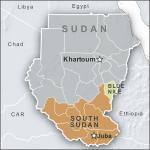Humanitarian agencies are preparing for an influx of refugees into Ethiopia from both Sudan and South Sudan. Civilians, mostly women and children, are fleeing fighting and violence in border areas.
Fighting continues in Sudan's Blue Nile State between government forces and the rebel SPLA North Sector. While in South Sudan's Jonglei State, ethnic violence stemming from cattle raids has left hundreds dead.
The U.N. refugee agency or UNHCR is coordinating relief efforts with the International Organization for Migration and the Ethiopian Relief and Rehabilitation Commission.
"There are expectations that a number of people fleeing the fighting will likely arrive in Ethiopia just as we have had cases, particularly between August and September last year when we had quite a number of people coming from Blue Nile State," said Josiah Oginah, IOM's chief of mission in Ethiopia.
Getting ready
It is unclear how many refugees will actually arrive in Ethiopia, but humanitarian agencies are planning for as many as 50,000.
"The number cannot be determined. It depends on who actually crosses the border. Sometimes those who cross the border may not necessarily be wanting to come into the refugee camps because some of them are people who also have some relations within the border area. So they may identify some relations that they would like to stay with host communities. So, determining the number is not easy," he said.
The International Organization for Migration currently has an office in Assosa, in the Benishangul-Gumuz region of Ethiopia. It handled many of the refugees who arrived late last year. However, the new influx is expected further south in the Gambela region.
Local groups have been contracted to shuttle the refugees to three camps: Tongo, Sherkole and Adamazine. All are located far from the border. It's estimated there are 35,000 refugees from Blue Nile State currently in Ethiopia, most of them in the camps.
The IOM's Oginah said the new arrivals appear to be fairly healthy overall.
"(The) majority of the people who arrive (a) significant number are women and children. I would say that some of them look tired because of the distances they have covered, but they're not in any bad health, nutrition conditions at all. They are just basically people who have been semi traumatized by having run away from hostilities. But health wise I think the majority of them are in reasonable shape," he said.
The IOM saids more funding is needed to help the refugees. It's appealed for one million dollars. It's received $300,000 from the UNHCR in response to that appeal.
Meanwhile, in South Sudan's Jonglei State, a four truck IOM convoy is carrying emergency non-food items to the town of Pibor. The aid includes plastic sheeting, jerry cans, kitchen utensils, blankets and soap. It's being delivered to about 7,500 people displaced by recent ethnic fighting between the Lou Nuer (LO NUR) and the Murle.
